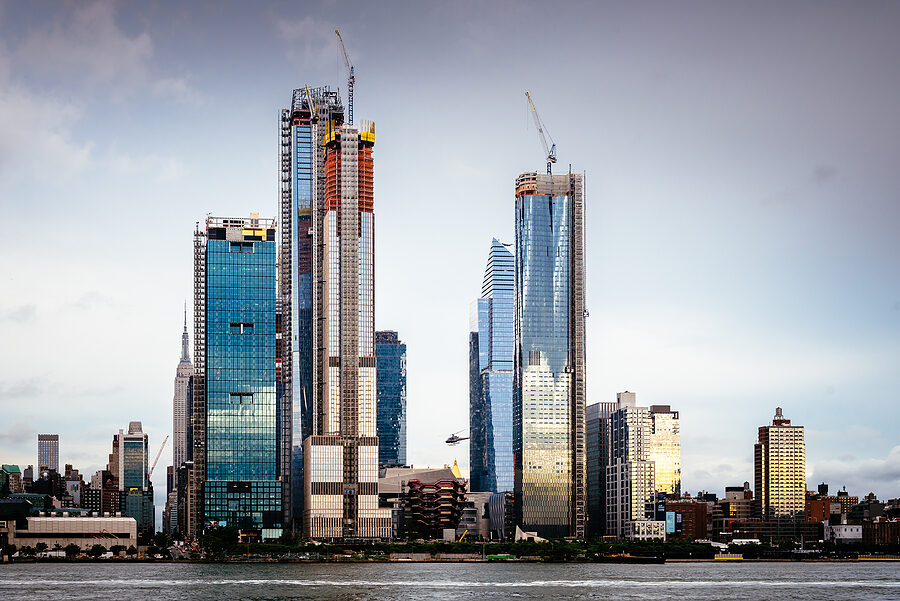NYC Construction: A Testament to Resiliency
By Frank Fortino
More than two years after COVID-19 shut down the country, the New York City construction industry has come a long way toward recovery, but the immediate future remains uncertain. The 2021 – 2023 New York City Construction Outlook, published by the New York Building Congress in its 100th year, forecasts increased employment even as overall construction spending contracts.
For the first time, this signature publication for our industry includes additional figures adjusted for inflation. Clearly, much work remains as we continue to grapple with the increased cost of labor and materials, as well as delays in federal infrastructure investments.
Construction Spending & Employment
The Building Congress forecasts total construction spending of $60.6 billion across the five boroughs for 2021. This number represents a $12.3 billion, or 26%, increase compared to 2020, when the pandemic forced New York City to shut down non-essential construction for 11 weeks. When compared to pre-pandemic levels, spending is $1.4 billion lower than 2019 in current dollars; that number increases to $6.4 billion when adjusted for inflation, representing a 10% decrease.
Total spending for the three-year period is estimated at $174.1 billion, with construction spending dipping to $56.8 billion in 2022 and $56.6 billion in 2023. Decreased activity in the residential and government sectors are expected to account for the $1.5 billion reduction, which translates into a $38.2 billion drop when adjusted for inflation and compared to the pre-pandemic period of 2017 to 2019.
While 2021 employment is estimated to total 135,000—its lowest level since 2014—the Building Congress forecasts that the industry could create a significant number of new jobs during the next two years. Employment in building construction, heavy and civil engineering, and specialty trades is expected to reach 140,200 and 157,100 in 2022 and 2023, respectively. This level of activity would put the employment level in 2023 at its third-highest peak in the history of the Construction Outlook report, exceeded only by 2018 and 2019.
Declining Residential Construction
Residential construction spending, which includes both new construction and alterations to existing buildings, is estimated at $13.9 billion for 2021 and expected to total $36.6 billion between 2021 and 2023. Again, this number represents an increase compared to 2020, but residential spending will likely be $5.5 billion in nominal dollars compared to 2019, a decrease of $7.3 billion when adjusted for inflation. Residential activity is expected to drop from 23% of total construction spending in 2021 to 19% by the end of 2023.
Residential construction is producing fewer units and less total floorspace. Between 2021 and 2023, the number of units constructed is expected to decrease 21% and gross square footage will drop 22% when compared to the three years before the pandemic. The Building Congress anticipates that new projects will add an average of 19,800 units each year between 2021 and 2023, a 21% drop from the 25,100 average between 2017 and 2019. New floorspace will continue to decline from an estimated 41.2 million gsf in 2021 to 35 million gsf in 2022 and 30 million gsf in 2023.
Surge in Non-Residential Spending
Most of the anticipated activity will occur in the non-residential sector, which includes office space, retail, hotels, institutional development, entertainment venues, and recreational facilities. Anticipated spending of $23.7 billion in 2021 is expected to drop to $22.4 billion in 2022 and then increase to $25 billion in 2023. Adjusted for inflation, spending is expected to decline to $20.2 billion in 2022 and $21.4 billion in 2023.
Similar to previous economic downturns, core-and-shell construction is expected to decline, with more interior renovations. Non-residential construction will add an estimated 33 million gsf in 2021, slipping to 32 million gsf and 31 million gsf over the next two years. These projections would represent the highest increases in annual floorspace with the exceptions of 2018 and 2019.
Reduced Infrastructure Investment
The Building Congress forecasts that government construction will decline, from $23.1 billion in 2021 to $22.2 billion and $21.1 billion in 2022 and 2023. Adjusted for inflation, these figures drop to $19 billion in 2022 and $16.8 billion in 2023. While public investments accounted for 44% of total construction spending in 2020, this number will likely fall between 37% and 39% from 2021 to 2023.
Despite delayed infrastructure investment from the federal government, the City of New York, the Metropolitan Transportation Authority, and the Port Authority of New York and New Jersey are all expected to increase spending during the forecasted period when compared to pre-pandemic levels in 2017-2019.


